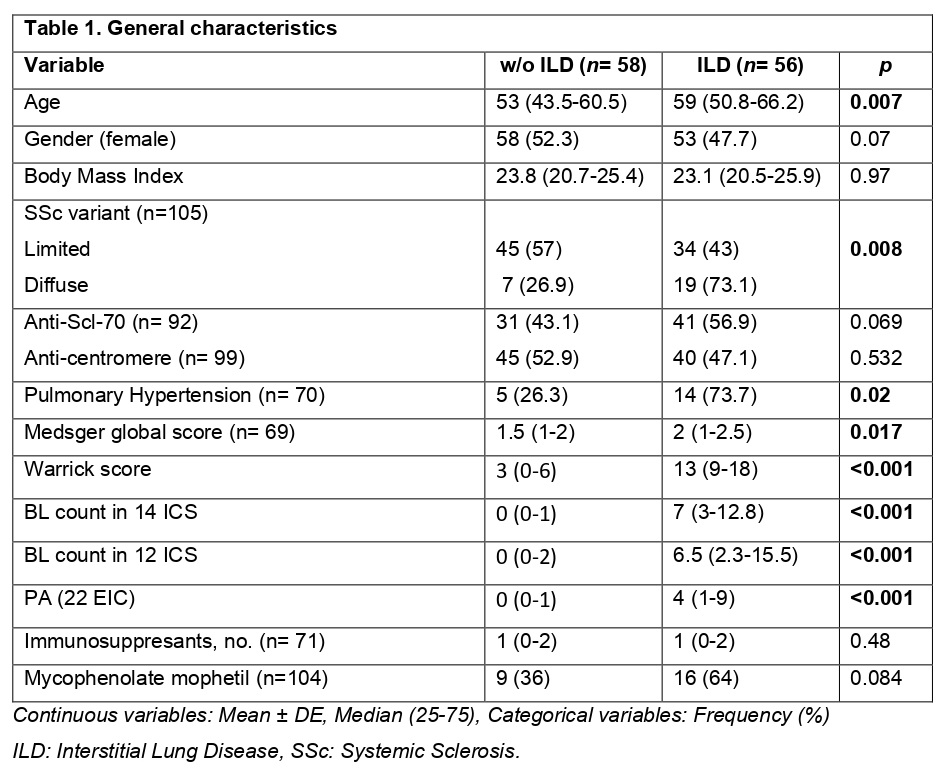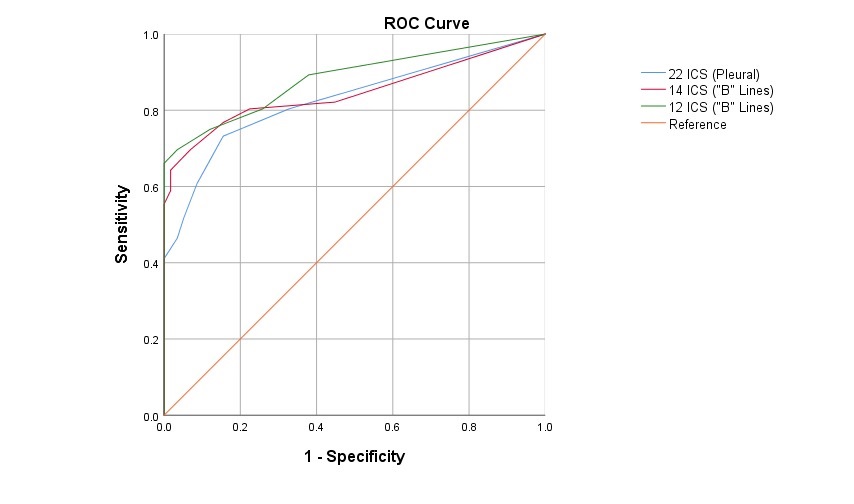Session Information
Session Type: Poster Session B
Session Time: 9:00AM-11:00AM
Background/Purpose: Lung ultrasound (LUS) has proven useful to detect interstitial lung disease (ILD) among patients with SSc when compared to high-resolution computerized tomography (HRCT) as the gold standard; it also exhibits advantages as a tool in clinical practice owing to its accessibility and innocuity. Nevertheless, a key drawback is currently the lack of a standardized methodology to perform LUS. Our objectives were to evaluate diagnostic accuracy of LUS for ILD by comparing the systematic evaluation of 14 intercostal spaces (ICS) against 12 postero-basal ICS; and to correlate the grade of severity of ILD assessed through LUS with findings on HRCT, both as a global score and evaluating specific concordant lung zones.
Methods: Patients with SSc, according to current classification criteria, were recruited from the outpatient rheumatology clinic at a referral hospital. Demographic, clinical, serological, and imaging variables were collected. LUS was performed using two scanning methods: 14 predetermined ICS and 12 postero-basal ICS. “B” lines (BL) and pleural abnormalities (PA) were documented for each ICS. HRCT was performed with a maximum 3 month-interval from the time of recruitment (before or after). Descriptive statistics, multivariate analysis, a Pearson correlation test (to compare findings between LUS and HRCT), and ROC curves (to show diagnostic accuracy) were carried out.
Results: We included 114 patients with a median age of 55 (IQR 48-63) years; 97.4% were women. Prevalence of ILD was 49.1%. Relevant baseline characteristics are shown in Table 1. Acknowledged risk factors for ILD were pulmonary hypertension (OR 3.4, CI 95% 1.04-11.14, p=0.04) and diffuse SSc (OR 2.5, CI 95% 0.84-7.6 p= 0.10). A strong correlation was shown between the BL count in 14 ICS and the Warrick score (0.62), and the BL count in 12 ICS and Warrick score (0.61).
The AUC were 0.85 (95% CI, 0.77-0.92), 0.88 (95% CI, 0.82-0.95) and 0.83 (95% CI, 0.75-0.91) for the evaluation of the number of BL in 14 ICS, 12 ICS and the number of ICS with PA (22 EIC), respectively.
Conclusion: Our study confirms the robustness of LUS as a tool for the detection of ILD through the quantification of BL and PA when using any of two different scanning protocols (14 and 12 ICS). A reasonable diagnostic accuracy was also proven for the finding of PA, but more studies are required to elucidate their added value over BL for the diagnosis of ILD by LUS.
To cite this abstract in AMA style:
Carranza Enriquez F, Soto-Fajardo C, Solorzano Flores S, Angeles-Acuña A, Mejia-Avila M, Vázquez-Ortega A, Flores-Ordoñez P, Arias Callejas K, Enriquez-Luna A, Ramon-Diaz G, Bravo-Zarate B, Rodríguez-Reyna T, Pineda C. Diagnostic Accuracy of Lung Ultrasound for Detecting Interstitial Lung Disease Among Patients with Systemic Sclerosis: A Comparative Study of Two Scanning Protocols [abstract]. Arthritis Rheumatol. 2023; 75 (suppl 9). https://acrabstracts.org/abstract/diagnostic-accuracy-of-lung-ultrasound-for-detecting-interstitial-lung-disease-among-patients-with-systemic-sclerosis-a-comparative-study-of-two-scanning-protocols/. Accessed .« Back to ACR Convergence 2023
ACR Meeting Abstracts - https://acrabstracts.org/abstract/diagnostic-accuracy-of-lung-ultrasound-for-detecting-interstitial-lung-disease-among-patients-with-systemic-sclerosis-a-comparative-study-of-two-scanning-protocols/


